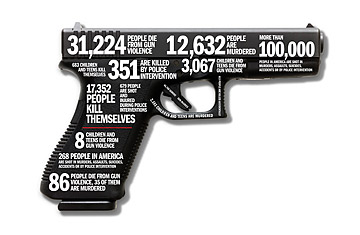As an Australian living in the US, it’s often hard for me to engage with debates on gun violence that sound exactly the same after every awful mass shooting that now seems to take place before we’ve even had time to grieve the last one. Even though I understand the history behind the 2nd Amendment, it feels very foreign to think of gun violence as a civil rights issue. To hear the word “rights” invoked by one of the richest and most powerful associations of white men who spend over $28 million dollars a year lobbying federal candidates.
Lobbying that clearly works, blocking any legislative initiatives to regulate guns, leaving the US with nearly twice as many guns per capita than any other nation in the world, while an average of 297 people are shot every day, 48 of those children. I’m especially puzzled that those “rights” are tied to some concept of safety, when the unfortunate but common sense reality is that possessing a gun makes both individuals and families more vulnerable, not less. In fact, having access to a gun actually makes you three times more likely to commit suicide and twice as likely to be a victim of homicide.
It’s offensive to keep hearing about mental illness being blamed for gun violence, when we know that the mentally ill are far more likely to be victims of violent crime rather than perpetrators. Never mind the “lone wolf” narrative, which is used to shift the responsibility to a single anomaly, the outcast. If loneliness and isolation are indicators, then those of us living in large urban cities should be worried. Of course, they’re not, because we know that 85% of shootings occur in social networks and people are far more likely to be shot by relatives, friends, enemies or acquaintances than by lone violent psychopaths.
But until the US realizes that aside from cute furry animals, Australia also has the most rational gun control laws, the public health approach offers a sensible way forward. And for anyone who hasn’t seen John Oliver’s brilliant and hilarious six minute insight into why the Australian approach could work here, I strongly urge you to do so.
A public health approach allows us to put aside political or ideological beliefs, and approach gun violence like any other preventable death burden that can be reduced through common sense measures. It acknowledges basic freedoms, and balances them against the burden to society as a whole. Tobacco, asbestos control and motor vehicle safety are just some examples where the public health interest in restricting certain behaviors has led to significant reductions in preventable deaths and injuries (though not without controversy at the time).
We accept many infringements on civil liberties in fights against infectious disease, such as compulsory vaccination, surveillance and quarantine. These and other common sense measures have allowed us to prevent major disease outbreaks and reduce the burden of preventable deaths from road accidents, smoking and workplace injuries. We can use these principles to consider a range of measures that can significantly reduce the burden of gun violence without having to trigger 2nd Amendment arguments. We discussed some of these here at the O’Neill Institute at a colloquium on gun violence – one of the simplest examples being implementing background checks for private sales, internet purchases and gun shows.
One fascinating comparison is that ten times as many people die of gun shots than food poisoning every year, yet we put billions of dollars into funding regulatory frameworks and a federal agency to prevent food poisoning outbreaks. And it works – the WHO just released data showing that the US has the lowest rates of food-borne illness in the world. At the same time, the US gun homicide rate is higher than any other developed nation, including Pakistan, and has only about two fewer deaths per 100,000 people than Iraq. The US then spends $2 billion a year in hospital charges treating victims of gun injuries – one in three of whom are uninsured.
I truly don’t understand how a country that is a leader on so many other issues can accept that children in the U.S. are 14 times more likely to die from guns than children in other developed countries.
Latest
India and the IHR Amendments: Strengthening Legal Preparedness for Global Health Security
Kashish Aneja Lawrence O. Gostin Sam Halabi




